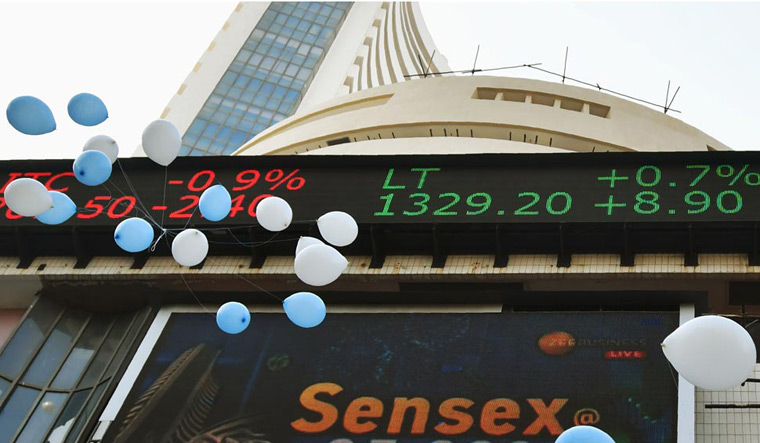The Bombay Stock Exchange’s benchmark Sensex breached the 39,000 mark for the first time on Monday, tracking gains across major global markets on the back of a rebound in Chinese manufacturing activity and expectations of a interest rate cut in the Reserve Bank of India’s monetary policy announcement later this week.
The BSE Sensex hit a high of 39,115.57 intra-day, before it closed at 38,871.87, up 199 points or 0.5 per cent. The NSE Nifty 50 index ended 32 points or 0.3 per cent higher at 11,655.60 points. Monday’s gains follow a strong performance by the frontline indices in March. Sensex rose almost 8 per cent last month, its best performance in almost three years.
There are multiple factors fuelling the markets higher. China’s PMI (purchasing managers index) showed manufacturing activity in March rose for the first time in four months. That drove major global equity markets higher on Monday. The Shanghai Composite Index jumped 2.6 per cent, Japan’s Nikkei Stock Average 225 rose 1.4 per cent, Hong Kong’s Hang Seng surged 1.8 per cent and Korea’s Kospi also rose 1.3 per cent. Major European equity markets were also trading 0.50 per cent to 1.0 per cent higher.
Back home, the RBI’s monetary policy committee meets this week and the expectation is that benign retail inflation will prompt a 0.25 per cent reduction in the repo rate. There is rising hope that a stable government will be elected in the Parliamentary elections this year, which is also a sentiment booster.
French bank BNP Paribas has upgraded India to “overweight.” Its strategy team sees a 60 per cent probability of Prime Minister Narendra Modi remaining in the “drivers seat” after elections. It is also upbeat on corporate earnings, asset quality of banks and private capital expenditure revival.
“We downgraded India in June 2018 on concerns about currency weakness, earnings downgrades and high valuation. The first concern appears clearly behind us. Earnings downgrade momentum has declined, though growth estimates in some sectors still appear overstated. However, private capex appears set to revive and the worst of banks’ asset quality problems seem a thing of the past,” said Manishi Raychaudhuri, Asia Pacific head of equity research at BNP Paribas.
Foreign institutional investors (FII)) pumped in Rs 33,981 crore in India’s equity markets in March, taking their total tally to Rs 46,939 crore in 2019 calendar year, versus Rs 33,014 crore outflows in 2018, according to data from depositories.
Raychaudhuri believes that the strong flows driven by expectation of the NDA government continuing after the general elections could keep valuations of India’s equities elevated.
Some of the major gainers on Monday included Tata Motors, which accelerated over 7 per cent on hopes of earnings improving at luxury Jaguar Land Rover unit. Bharti Airtel, Tata Steel, Maruti Suzuki, Reliance and Larsen and Toubro also gained over 2 per cent.
Worries over a possible recession in developed markets maybe a reason for India receiving the largest share of FII flows, excluding China, opines Sanctum Wealth Management.
“The global developed economy is back to square one, with global markets expecting synchronised stimulus and rate cuts... As such, the accomodative stance of central bankers is the primary catalyst for the multi-asset gains witnessed year to date 2019,” Sanctum said.
It says India’s valuations have stayed elevated on visible long-term growth, structural reforms and declining inflation. Low inflation make real yields attractive, which will sustain markets along with rate cuts, it added.
“With strong multi-billion dollar commitments by foreign investors, it is likely the market hits new highs. Should the incumbent party win, significant domestic capital is likely to further flood the market,” said Sanctum.
BNP Paribas’ Raychudhuri believes real interest rates in India still are “way too high” and there is a “significant” scope for reduction unless there is an inflationary shock, and the possibility of it is remote in the current environment of benign food and commodity prices.



